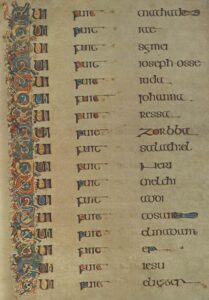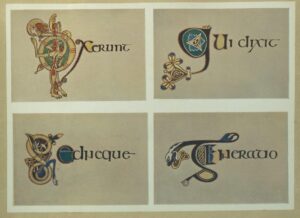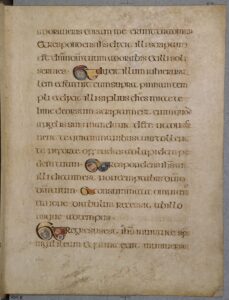The Book of Kells: Image and Text / Introduction to the Book of Kells
- Elaine Harrington
- May 29, 2017
Student Exhibition, MA in Medieval History
Introduction to the Book of Kells
The Book of Kells, Trinity College Dublin, MS 58, widely recognised as one of Ireland’s most significant medieval treasures, is a wonderful example of an Insular Gospel book. The term ‘Insular’ is used by scholars to describe manuscripts created in Ireland and Anglo-Saxon England, and in the Irish and English monastic centres on the continent, between the sixth and ninth centuries. Dated to the early ninth century, the Book of Kells is referred to in the later Annals of Ulster as ‘the great Gospel of Colmcille’, with this annalistic entry showing the association of the Book of Kells with the sixth-century Irish saint, Columba (Colmcille) of Iona. Modern scholars believe that the book was likely created in one of the Columban monasteries, which included Kells, Co. Meath and the island of Iona.

In 1006, the manuscript by then regarded as ‘the chief treasure of the western world’, was stolen from the sacristy of the monastery of Kells as recorded by the Annals of Ulster. It was recovered two months later, found under a sod of earth and returned to Kells. In 1653 the book was brought to Dublin and placed in Trinity College for safety. The renowned scholar James Ussher (1581-1656), who studied and taught at Trinity College and later became the Anglican Archbishop of Armagh, is credited with calling the manuscript the Book of Kells. The manuscript has been rebound five times and is now bound in four volumes, two of which are on display in the eighteenth-century Old Library building at Trinity College Dublin.
The Book of Kells currently contains 340 folios, that is 680 pages, and it is estimated that sixty folios have been lost. The text of the four Gospels draws from both the Latin text of the Vulgate translation by St Jerome (347-420) and an earlier Old Latin translation. Placed before the Gospels are: a list of Hebrew names that survives only on one page, canon tables designed to evoke the harmony of the Gospels, the breves causae which summarise the Gospels and the argumenta that contain biographies of the Evangelists. The Book of Kells also contains later additions such as a fifteenth-century poem describing it as a relic of St Columba and a record of property transactions written in Irish and pertaining to the monastery at Kells.

The Book of Kells is the most richly decorated Insular manuscript that survives and the colours used in its illumination are far more diverse than in other Gospel books such as the Book of Durrow or the Lindisfarne Gospels. Preceding each Gospel text in the Book of Kells is the image of the four Evangelist symbols, followed by a decorated opening initial. Originally each Gospel may have opened with a miniature of the relevant Evangelist, with only two portraits of Matthew and John now surviving. Other Gospel passages such as the account of the Nativity (Chi Rho page) are highlighted for spiritual or liturgical reasons. The Book of Kells also depicts scenes which may be regarded as narrative such as the Arrest of Christ, folio 114r and the Temptation of Christ, folio 202v. As will be discussed later in relation to the Temptation miniature, and expounded by the ground-breaking studies of Jennifer O’Reilly, these images act as visual exegesis, that is a visual commentary on complex biblical themes and their meaning.
The Book of Kells was a combined effort of a monastic community. Françoise Henry in her pioneering work on early Irish art, argued that three scribes with their own distinctive styles had been part of the production of the manuscript. It is now considered that possibly four scribes were involved. Three illuminators were also involved in the creation of the manuscript. The painter of the Chi Rho page is distinguished by his usage of gold filigree designs, while the creator of scenes such as the Temptation and the Arrest of Christ focused on usage of vivid colours and therefore has been given the title of the Illustrator.
The Book of Kells primarily functioned as a ceremonial book to be used at special liturgical occasions as can be deduced from its lavish design.
Listen to an audio recording of Vicky Janssens reading TCD MS 58 folio 204r.
Donncdha Carroll
Further reading
Colker, Marvin L., Trinity College Library Dublin: Descriptive Catalogue of the Medieval and Renaissance Latin Manuscripts (Aldershot: Scolar Press 1991).
Farr, Carol Ann, The Book of Kells: Its Function and Audience (Toronto: University of Toronto Press, 1997).
Henry, Françoise, Early Christian Irish Art (Dublin: Cultural Relations Committee of Ireland, 1965).
Herbert, Máire, Iona, Kells and Derry: The History and Hagiography of the Monastic ‘Familia’ of Columba (Oxford: Clarendon, 1988).
McGurk, Patrick, Latin Gospel Books from A.D. 400 to A.D. 800 (Paris: Éditions Érasme, 1961).
McNamara, Martin, Studies on Texts of Early Irish Latin Gospels: A.D. 600-1200 (Dordrecht: Kluwer Academic Publishers, 1990).
Meehan, Bernard, The Book of Kells (New York: Thames and Hudson, 2012).
O’Mahony, Felicity, ed., The Book of Kells: Proceedings of a Conference at Trinity College, Dublin, 6-9 September 1992 (Aldershot: Scolar Press, 1994).

